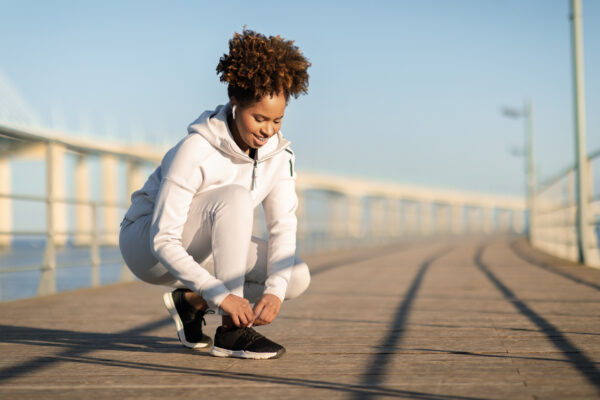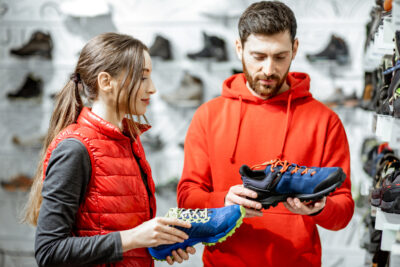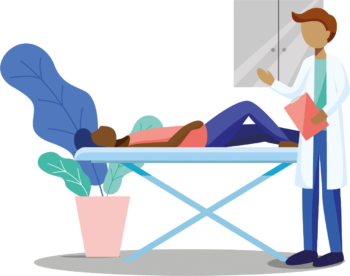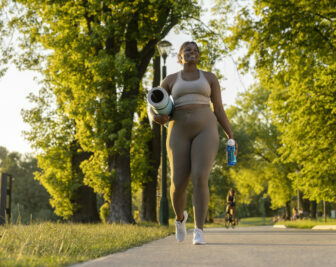By Christina DeBusk
Research indicates that “footwear is the oldest known fashion accessory in use,” with evidence suggesting that people were wearing something on their feet by the Stone Age. Since that time, we’ve seen numerous advances in footwear, providing benefits to athletes and non-athletes alike. Though opinions may differ on how exactly these advances affect performance, there’s no denying that athletic footwear has come a long way.
Footwear Advances for Athletes
One benefit of the footwear evolution that some point to is enhanced sports performance. For example, a 2021 study noted that after advanced shoe technology was introduced, elite runners participating in long-distance events such as half and full marathons significantly decreased their seasonal best times. But what types of changes may be offering these effects?

“There are predominantly three things they’re doing with shoes that have really changed how athletes perform,” explains Ted Forcum, DC, an American Chiropractic Association (ACA) Sports Council member who practices in Astoria, Ore., and team chiropractor for the Portland Winterhawks. The first change is reducing the weight of the midsole, which is the cushioned material that sits between the foot and the outer sole of the shoe.
Even a small decrease in the weight of the midsole can have a major impact for athletes. “Let’s say that you make a tenth of a pound change in something on a shoe,” says Dr. Forcum. “You’ve now increased the weight an athlete lifts by 8,400 pounds over the course of a marathon. If you’re looking at the difference between winning and losing, it makes a big difference.”
Other footwear changes that have helped improve athletic performance in recent times include changing the shape of the midsole and using a carbon fiber plate. This plate makes for a more rigid shoe but also “creates a springlike action,” Dr. Forcum says, much like shocks on a car.
Orthotics Have Advanced Too
Footwear isn’t the only thing that’s changed. So too have orthotics, which are devices that you wear in your shoes to help correct foot issues.
“There’s been a complete shift in how foot orthotics work,” shares Dr. Forcum, adding that today’s orthotics are more neurologic. This means that they interact more effectively with our nervous system, which includes our brain, spinal cord, and all of our body’s nerves.
As an example, a small 2020 study found that using textured foot orthotics helped individuals with Parkinson’s disease complete a 180-degree turn by changing their stability and turning performance. Parkinson’s is a disorder that impacts the nervous system, generally resulting in tremors, rigid muscles, and slow movement.
There are two types of orthotics: accommodative and functional. “Accommodative orthotics are designed to protect the foot,” says Dr. Forcum, making them good choices for a person who has diabetes or who is experiencing some type of foot irritation.
Functional orthotics, on the other hand, are designed to create changes in how the foot moves. That makes them ideal for people with tissue tension imbalances. A sign of this type of imbalance is if you have pain on one side of your leg but not the other. “Orthotics have a high success rate for that,” says Dr. Forcum.
Why Footwear and Foot Health Are So Important
Maybe you’re not an athlete who is worried about your running times and you also aren’t experiencing any foot issues. Why should footwear specifically and foot health overall even be a priority for you?
“Your ability to squat and how fast you walk and your ability to get off the ground—those are big markers in how long you live,” stresses Dr. Forcum. “That’s why I look at these things as super important. It’s about keeping you happy, healthy, and in this world longer.”
Dr. Forcum compares not taking care of your feet to not caring for your car. “It’s like repairing a rattle in the car but not changing your oil,” Dr. Forcum says. “The rattle may drive you nuts but changing the oil is essential.”
The One Thing to Look for When Buying Athletic Shoes

If you’re in the market for new athletic shoes, you may be wondering which ones are best for you. With so many features to choose from, selecting the right pair can feel overwhelming. But it doesn’t have to be because Dr. Forcum says that there’s only one thing you need to look for when buying athletic shoes: comfort.
“Everyone has their own path of how they move through this world,” explains Dr. Forcum. “We just want a shoe that supports this path in the safest manner possible. For most people, that’s really going to be the shoe that’s most comfortable. Your body will intuitively figure out that what’s best for you.”
Put on the shoes at the store, walk around a bit, and see how they feel. Dr. Forcum also recommends taking the shoes home and wearing them inside your house. This gives you a better idea of how they feel during your typical everyday movements. And if it turns out to be not the right pair for you, you can likely take them back as most shoe stores will allow you to return footwear if it wasn’t worn outside and isn’t scuffed up.
Additional Ways to Improve Foot Health
Dr. Forcum offers a few additional suggestions for improving the health of your feet. One is to buy two different pairs of shoes and rotate them. “You’re going to allow for the ability of the foam to re-expand so it absorbs shock more efficiently,” Dr. Forcum explains.
Plus, one shoe might put a little more stress on one area of the body than another. Switching between two pairs prevents you from stressing that area of the body too much. It’s also helpful to choose a shoe that matches the shape of your feet. (Women tend to have different foot shapes than men.)
Dr. Forcum further recommends developing strength in your hips and glutes, or buttock muscles, as well as improving your intrinsic foot strength. To improve foot strength, perform actions that involve curling your toes. Sit in a chair, for example, and try to pick up small objects by curling your toes around them.
Watching your posture is another way to improve foot health. If your head and shoulders lean forward a lot, this increases the load on your feet.
Your Chiropractor Can Help
Finally, don’t be afraid to talk to your chiropractor about your concerns. Ask them what type of shoes would be helpful for you, or if you could benefit from orthotics.
Chiropractors are trained to treat musculoskeletal issues, such as those created by misalignments or dysfunctions in the feet. They’re also focused on improving neurological health, which can further benefit how your feet feel.
In the meantime, we’re likely to continue to see changes in footwear technology, but these changes often come full circle. It’s like how we started with a middle-of-the-line shoe, then trends swung toward a more minimalist shoe, then they went the opposite direction to a maximalist shoe and will likely settle back to the midline.
But once we return to the midline, it’s not the same because we’re able to apply the knowledge that we gained along the way. “The concept looks different than it was before,” says Dr. Forcum, resulting in a new and improved footwear option.
Christina DeBusk is a freelance contributor to Hands Down Better.
Reviewed by the ACA Editorial Advisory Board. The information in this post is for educational purposes. It is not a replacement for treatment or consultation with a healthcare professional. If you have specific questions, contact your doctor of chiropractic. To find an ACA chiropractor near you, visit www.HandsDownBetter.org.



